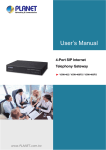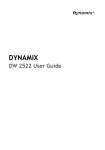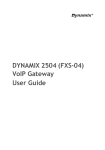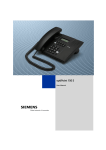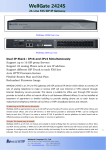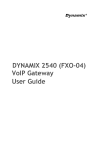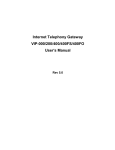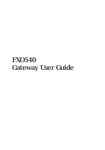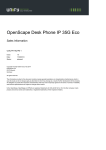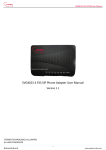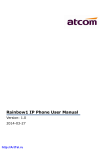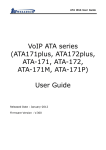Download 4-Port SIP VoIP Gateway - PLANET Technology Corporation.
Transcript
Internet Telephony Gateway VGW-400 Series 4-Port SIP VoIP Gateway VGW-402 / VGW-400FS / VGW-400FO 1 Internet Telephony Gateway VGW-400 Series Copyright Copyright© 2013 by PLANET Technology Corp. All rights reserved. No part of this publication may be reproduced, transmitted, transcribed, stored in a retrieval system, or translated into any language or computer language, in any form or by any means, electronic, mechanical, magnetic, optical, chemical, manual or otherwise, without the prior written permission of PLANET. PLANET makes no representations or warranties, either expressed or implied, with respect to the contents hereof and specifically disclaims any warranties, merchantability or fitness for any particular purpose. Any software described in this manual is sold or licensed "as is". Should the programs prove defective following their purchase, the buyer (and not this company, its distributor, or its dealer) assumes the entire cost of all necessary servicing, repair, and any incidental or consequential damages resulting from any defect in the software. Further, this company reserves the right to revise this publication and to make changes from time to time in the contents hereof without obligation to notify any person of such revision or changes. All brand and product names mentioned in this manual are trademarks and/or registered trademarks of their respective holders. Disclaimer PLANET Technology does not warrant that the hardware will work properly in all environments and applications, and makes no warranty and representation, either implied or expressed, with respect to the quality, performance, merchantability, or fitness for a particular purpose. PLANET has made every effort to ensure that this User’s Manual is accurate; PLANET disclaims liability for any inaccuracies or omissions that may have occurred. Information in this User’s Manual is subject to change without notice and does not represent a commitment on the part of PLANET. PLANET assumes no responsibility for any inaccuracies that may be contained in this User’s Manual. PLANET makes no commitment to update or keep current the information in this User’s Manual, and reserves the right to make improvements to this User’s Manual and/or to the products described in this User’s Manual, at any time without notice. If you find information in this manual that is incorrect, misleading, or incomplete, we would appreciate your comments and suggestions. Trademarks The PLANET logo is a trademark of PLANET Technology. This documentation may refer to numerous hardware and software products by their trade names. In most, if not all cases, these designations are claimed as trademarks or registered trademarks by their respective companies. CE mark Warning This is a class B device, in a domestic environment; this product may cause radio interference, in which case the user may be required to take adequate measures. 2 Internet Telephony Gateway VGW-400 Series Federal Communication Commission Interference Statement This equipment has been tested and found to comply with the limits for a Class B digital device, pursuant to Part 15 of FCC Rules. These limits are designed to provide reasonable protection against harmful interference in a residential installation. This equipment generates, uses, and can radiate radio frequency energy and, if not installed and used in accordance with the instructions, may cause harmful interference to radio communications. However, there is no guarantee that interference will not occur in a particular installation. If this equipment does cause harmful interference to radio or television reception, which can be determined by turning the equipment off and on, the user is encouraged to try to correct the interference by one or more of the following measures: 1. Reorient or relocate the receiving antenna. 2. Increase the separation between the equipment and receiver. 3. Connect the equipment into an outlet on a circuit different from that to which the receiver is connected. 4. Consult the dealer or an experienced radio technician for help. FCC Caution: To assure continued compliance (example-use only shielded interface cables when connecting to computer or peripheral devices). Any changes or modifications not expressly approved by the party responsible for compliance could void the user’s authority to operate the equipment. This device complies with Part 15 of the FCC Rules. Operation is subject to the Following two conditions: (1) This device may not cause harmful interference, and (2) this Device must accept any interference received, including interference that may cause undesired operation. R&TTE Compliance Statement This equipment complies with all the requirements of DIRECTIVE 1999/5/EC OF THE EUROPEAN PARLIAMENT AND THE COUNCIL OF 9 March 1999 on radio equipment and telecommunication terminal Equipment and the mutual recognition of their conformity (R&TTE) The R&TTE Directive repeals and replaces in the directive 98/13/EEC (Telecommunications Terminal Equipment and Satellite Earth Station Equipment) As of April 8, 2000. 3 Internet Telephony Gateway VGW-400 Series WEEE Caution To avoid the potential effects on the environment and human health as a result of the presence of hazardous substances in electrical and electronic equipment, end users of electrical and electronic equipment should understand the meaning of the crossed-out wheeled bin symbol. Do not dispose of WEEE as unsorted municipal waste and have to collect such WEEE separately. Safety This equipment is designed with the utmost care for the safety of those who install and use it. However, special attention must be paid to the dangers of electric shock and static electricity when working with electrical equipment. All guidelines of this and of the computer manufacture must therefore be allowed at all times to ensure the safe use of the equipment. Customer Service For information on customer service and support for the Planet Product, please refer to the following Website URL: http://www.planet.com.tw Before contacting customer service, please take a moment to gather the following information: • Internet Telephony Gateway System serial number and MAC address • Any error messages that displayed when the problem occurred • Any software running when the problem occurred • Steps you took to resolve the problem on your own Revision User’s Manual for PLANET Internet Telephony Gateway Model: VGW-400 Series Rev: 1.0 (October, 2013) 4 Internet Telephony Gateway VGW-400 Series TABLE OF CONTENTS Chapter 1 Introduction.................................................................................................... 7 1.1 Features .............................................................................................................................10 1.2 Package Contents ..............................................................................................................12 1.3 Physical Specifications .....................................................................................................12 1.4 Specifications ....................................................................................................................14 Chapter 2 Installation Procedure ................................................................................. 20 2.1 Web Login.........................................................................................................................20 2.2 Configuring the Network Setting ......................................................................................21 2.3 Changing IP Address or Forgotten Admin Password ........................................................22 Chapter 3 Device Setting.............................................................................................. 23 3.1 Network Configuration .....................................................................................................23 3.2 Device Time Setting..........................................................................................................25 3.3 Device Advance Setting ....................................................................................................27 3.4 User Login Setting ............................................................................................................27 3.5 Debug Setting....................................................................................................................28 3.6 Event Notice......................................................................................................................29 3.7 Auto Provisioning .............................................................................................................29 3.8 SNMP................................................................................................................................30 3.9 PABX Mode ......................................................................................................................31 Chapter 4 NAT Setting .................................................................................................. 33 4.1 DHCP Srv.(DHCP Server) ................................................................................................33 4.2 UPNP (Universal Plug and Play server)............................................................................33 4.3 Bandwidth (Bandwidth Control).......................................................................................33 4.4 URL Filter .........................................................................................................................37 4.5 IP Filter..............................................................................................................................38 4.6 MAC Filter........................................................................................................................38 4.7 APP Filter ..........................................................................................................................39 4.8 Port Filter ..........................................................................................................................39 4.9 Port Fwd............................................................................................................................39 Chapter 5 VoIP Setting.................................................................................................. 40 5.1 SIP.....................................................................................................................................40 5.2 Audio.................................................................................................................................41 5.3 Tone...................................................................................................................................42 5.4 NAT Traversal ...................................................................................................................42 Chapter 6 VoIP Advance ............................................................................................... 44 5 Internet Telephony Gateway VGW-400 Series 6.1 SIP.....................................................................................................................................44 6.2 SIP.....................................................................................................................................47 6.3 Ring...................................................................................................................................48 Chapter 7 Dialing Plan .................................................................................................. 49 7.1 General ..............................................................................................................................49 7.2 Dialing Rule ......................................................................................................................49 7.3 Digit Manipulation............................................................................................................50 7.4 Phone Book .......................................................................................................................51 Chapter 8 FXS Setting .................................................................................................. 53 8.1 FXS Line ...........................................................................................................................53 8.2 SIP Proxy ..........................................................................................................................56 8.3 Caller ID............................................................................................................................57 8.4 Others................................................................................................................................58 Chapter 9 FXO Setting .................................................................................................. 59 9.1 FXO line............................................................................................................................59 Chapter 10 SIP Trunk .................................................................................................... 62 10.1 Create SIP Trunk .............................................................................................................62 Chapter 11 Route Plan .................................................................................................. 66 11.1 For PABX Mode interface...............................................................................................66 11.2 For Non-PABX Mode interface.......................................................................................70 Chapter 12 Status.......................................................................................................... 74 12.1 Device Status...................................................................................................................74 12.2 Line Status.......................................................................................................................74 12.3 SIP Trunk Status ..............................................................................................................75 Chapter 13 Maintenance............................................................................................... 76 13.1 Firmware Update.............................................................................................................76 Appendix A - Default Setting ....................................................................................... 77 Appendix B - Changing IP Address or forgotten admin password........................... 78 6 Internet Telephony Gateway VGW-400 Series Chapter 1 Introduction Cost-effective, High-performance PoE VoIP Phone To build high-performance VoIP communications at a low cost, PLANET now introduces the latest member of its gateway family, the VGW-400 Series enterprise-class 4-port SIP VoIP Gateway. The VGW-400 Series provides added flexibility during migration to Unified Communications by supporting the traditional analog devices. These devices include analog phones, fax machines, modems, voicemail systems, and speakerphones. It helps the company to save money on long-distance calls; for example, the remote workers can dial in through a Unified VoIP Communication System just like an extension call but no long-distance call charge would occur. The VGW-400 Series also allows call to be transferred to anyone at any location within the voice system, which enables the enterprise to communicate more effectively and is helpful to streamline business processes. Standard Compliance The VGW-400 Series supports Session Initiation Protocol 2.0 (RFC 3261) for easy integration with general voice over IP system. The VGW-400 Series is able to broadly interoperate with equipment provided by VoIP infrastructure providers, thus enabling them to provide their customers with better multi-media exchange services. 7 Internet Telephony Gateway VGW-400 Series Enhanced, Full-Featured Business Gateway The VGW-400 Series is a full-featured enhanced business SIP Gateway that addresses the communication needs of the enterprises. It provides the FXO and FXS gateway with SIP protocol IP device which allows connection with PSTN telephone line and with analog telephone set to make or receive VoIP call over Internet or VPN network. This device is suitable for office PABX to enable to have VoIP call without changing cabling, dial plan and extension number. The VGW-400 Series supports all kinds of SIP-based gateway features and multiple contact filter functions, such as 4 SIP trunk accounts, both IPv6 and IPv4 protocols, flexible dial plan and route plan features, and switch analog and VoIP signal to help both protocols to communicate. Secure, High-Quality VoIP Communication It can effortlessly deliver secured toll voice quality by utilizing cutting-edge 802.1p QoS 8 Internet Telephony Gateway VGW-400 Series (Quality of Service), 802.1Q VLAN tagging, and IP TOS (Type of Service) technology. Using voice and data VLAN can easily separate the data and voice, thus maintaining the best quality. Supporting Caller ID Both the FXS and FXO ports of the VGW-400 Series support caller ID function, help user identify calling number easily and verify number. It also helps to block anonymous call by filtering strange calls. The FXS port transmits Caller ID, while the FXO port receives Caller ID. The Caller ID interoperates with analog phones, public switched telephone networks (PSTN) and private branch exchanges (PBXs). 9 Internet Telephony Gateway VGW-400 Series 1.1 Features ¾ Highlights Supports SIP 2.0 (RFC3261) Supports IPv6 and IPv4 simultaneously Up to 4 SIP service domains and Caller ID Supports auto HTTP provision and fax feature Flexible Routes Plan, Dial Plan and SIP Trunk Life-line for emergency calls ¾ Internet Features IPv4 (RFC 791) and IPv6 IPv6 auto configuration (RFC 4862) IPv6 only, IPv4 only or dual stack MAC clone setting Vendor Class ID DDNS ( Planet DDNS, Easy DDNS, DynDNS) DNS client Firewall URL / IP / MAC / Port Filter Port forwarding (TCP, UDP or both) Bandwidth control (download and upload), maximum bandwidth priority setting ¾ SIP Applications SIP Session Timer (RFC 4028) SIP Session Refresher: UAC or UAS SIP Encryption Supports Outbound Proxy / STUN NAT Traversal Supports Primary and Backup SIP Server ¾ Call Features Supports peer to peer dialing 2-line FXO connects to PSTN line 2-line FXS connects to analog phone set or PABX. Caller ID recognition DTMF (before/after 1st ring) and FSK (before 1st ring ), ETSI and Bellcore DTMF Caller ID start and stop BIT configurable T.38 fax volume configuration 10 Internet Telephony Gateway VGW-400 Series ¾ FXO/FXS Line Configuration Line ID / Line Phone number Polarity Reversal detection or generation for call establish and billing VoIP dial to FXO/PSTN Line: 1 stage dialing and 2 stage dialing Outgoing SIP Caller ID selection Caller ID detection mode by country selection ¾ Routing Plan Prefix match and length Priority / Cyclic / Simultaneous Ring Programmable Hunting Cycle 11 Internet Telephony Gateway VGW-400 Series 1.2 Package Contents Thank you for purchasing PLANET Internet Telephony Gateway system, VGW-400 Series. This Quick Installation Guide will introduce how to finish the basic setting of connecting the web management interface and the Internet. Open the box of the Internet Telephony Gateway system and carefully unpack it. The box should contain the following items: z VGW-400 Series x 1 z Quick Installation Guide x 1 z User’s Manual CD x 1 z Power Adapter x 1 (12V) z RJ-45 x 1 If any of above items are damaged or missing, please contact your dealer immediately. 1.3 Physical Specifications ¾ Dimensions Dimension 175 × 32 ×126 mm Net weight 500g (with package) Front Panel of the VGW-400 Series Rear Panel of the VGW-400 Series (VGW-402) Rear Panel of the VGW-400 Series (VGW-400FS) 12 Internet Telephony Gateway VGW-400 Series Rear Panel of the VGW-400 Series (VGW-400FO) LED definitions LED definitions LED Function Description Power When the power adapter is connected, the LED will light up green. Status When system startup successfully, the LED will light up green. Proxy When the gateway is registered successfully to a SIP Proxy, this will light up green. WAN This LED lights up green when the gateway’s WAN port is physically connected to the public internet. When data is transmitted through this port, it will flash green. LAN This LED lights up green when the gateway’s LAN port is physically connected to a local network (Refer to Rear Panel section). When data is transmitted through this port, it will flash green. Port 1 - 4 The status LED for FXO and FXS ports, these LED light up amber orange when connected phone is engaged in a conversation mode (FXO). It will flash amber orange when there is an incoming call (FXS). Port Function Description Reset Press and hold over 5 seconds to reload factory default setting, this action will erase all existing settings configured on this gateway. FXS Ports The status LED for FXS port, it will light up amber orange when the connected phone’s handset is lifted, or when the connected 13 Internet Telephony Gateway VGW-400 Series phone is engaged in a conversation. It will flash amber orange when there is an incoming call. The status LED for FXO port. When there is no PSTN line FXO Ports connected, this LED becomes blinking to remind you. When PSTN line is connected and no talking, the LED is OFF. When a line is using, the LED becomes steady light up. 10/100 Base-T RJ-45 socket for LAN port, connects to PC for LAN management purpose. 10/100 Base-T RJ-45 socket for WAN port, connects to wide WAN area network. The power socket, input AC 100V~240V; output DC12V, 2A DC 12V Button Action Reset Description Press less than 5 secs System reboot. Press over 5 secs Reset to Factory Default Please be reminded to reset to factory default. Uploaded music setting (on hold music) and backup file will not be removed. 1.4 Specifications Product VGW-400 Series Hardware WAN LAN Voice 1 x 10/100Mbps RJ-45 port 1 x 10/100Mbps RJ-45 port 4 x RJ-11 connection (VGW-402: 2 x FXS, 2 x FXO) (VGW-400FS: 4 x FXS) (VGW-400FO: 4 x FXO) Protocols and Standard IPv4 (RFC 791) and IPv6 IPv6 auto configuration (RFC 4862) Data Networking IPv6 only, IPv4 only or dual stack MAC address (IEEE 802.3) MAC clone setting 14 Internet Telephony Gateway VGW-400 Series Vendor Class ID IP/ICMP/ARP/RARP/SNTP Static IP DHCP Client (RFC 2131), WAN port DHCP Server, LAN port NAT Server (RFC 1631) PPPoE Client / DNS Client / TFTP Client DDNS (Planet DDNS, Easy DDNS, DynDNS) Firewall URL / IP / MAC / Port Filter Application Program Filter Port Forwarding (TCP, UDP or both) Bandwidth control (download and upload), maximum bandwidth priority setting UPnP Server at LAN port Behind NAT, use DMZ for NAT traversal SNTP with time zone and Daylight Saving TCP/UDP (RFC 793/768), RTP/RTCP (RFC 1889/1890), IPV4 ICMP (RFC 792) VoIP VLAN Support 802.1Q, 802.1P VLAN ID Range: 2 to 4094 VLAN Priority: 0 to 7 (Highest Priority) QoS: DiffServ (RFC 2475), TOS (RFC791, 1394) RFC3261 compliance Supports up to 4 SIP Trunks to Register SIP UDP Protocol Supports SIP compact Form Supports SIP HOLD Type: Send Only, 0.0.0.0 or inactive SIP Session Timer (RFC 4028) Voice Gateway SIP Session Refresher: UAC or UAS SIP Encryption MD5 Digest Authentication (RFC2069/RFC2617) Reliability of provision response PRACK (RFC3262) Early/Delay Media support Offer/Answer (RFC3264) Message Waiting Indication (RFC3842) Event Notification (RFC3265) 15 Internet Telephony Gateway VGW-400 Series REFER (RFC3515) Supports Outbound Proxy Supports Primary and Backup SIP Server Supports STUN NAT Traversal Supports “rport” parameter (RFC 3581) Configure SIP local Port SIP QoS Type: DiffServe or QoS Accept Proxy Only : Yes or No G.711 A-law/μ-law, G.729A, G.723.1 (6.3K, 5.3K) Select voice codec priority : Local or Remote Voice Payload size (ms) configuration Silence Suppression VAD/CNG LEC : Line Echo Canceller Max Echo Tail Length (G.168): 32, 64 and 128ms Packet Loss Compensation Automatic Gain Control Audio Codec In-band/out of band DTMF (RFC4733, RFC2833 / SIP INFO) Adaptive/Configurable Jitter Buffer G.168 Acoustic Echo Cancellation Configure RTP basic Port RTP QoS Type : DiffServ or TOS Phone Book ( 50 records ) for peer to peer calls Dialing Plan with drop, replace, Insert dialing digits Selects first digit and inter digit timeout duration (Sec) Selectable Call Progress Tone Support Specified Line Calling Functions 16 Internet Telephony Gateway VGW-400 Series Call Functions Supports Peer to Peer dialing FXO connects to PSTN Line FXS connects to analog phone set or PABX. Caller ID recognition DTMF (before/after 1st ring) and FSK (before 1st ring ), ETSI and Bellcore DTMF Caller ID start and stop BIT configurable Current Drop Detection to release FXO port Disconnect tone recognition to release FXO port Tone Generation: Ring Back, Dial, Busy, call waiting, ROH, Warning, Holding, Stutter dial tone and disconnect tone Configure Tone Frequency, Cadence, Level and Cycle Select Tone specification by Country name List Global Country Based Tone Specification NAT Traversal support STUN, UPNP and Behind NAT Out-Band DTMF with RFC2833 and SIP Info RFC2833 Payload type: 101 or 96 DTMF send out ON and OFF Time configure DTMF incoming recognition Minimum ON and OFF time DTMF Relay Volume configuration T.38 FAX Volume configuration Flash Time transmit via SIP Info (Enable or Disable) Message Waiting Indication (Stutter Tone Notice) Blocks Anonymous Call Call Hold , Call Transfer FXO/FXS Line Configuration Activates or deactivates : Line ID, Line Phone number Polarity Reversal detection or generation for call establish and Billing HOT Line to desired phone number Plays voice file to incoming call Repeats playing voice file counts Self-recorded voice files to upload Generates FLASH TIME to PSTN network T.38 or FAX Relay Type Incoming and outgoing dB value configurable Dialing Answer Delay time to establish call path Answers PSTN incoming call after how many ring cycles Caller ID detection mode by Country selection VoIP dial to FXO/PSTN Line: 1 stage dialing and 2 stage dialing 17 Internet Telephony Gateway VGW-400 Series Outgoing SIP Caller ID Selection Supports 4 SIP Trunk Accepts desired SIP Proxy incoming calls Only Flexible Routing Plan Prefix Match and Length Priority Ring Cyclic Ring Simultaneous Ring Programmable Hunting Cycle Backup Routes with Digit Manipulation Default Routes Flexible Dial Plans Retrieves transfer call from 3rd party by dial code (default: *#) Inter digit time out setting First digit dial out delay time setting End of dial keypad number Dial Rule : Match dial prefix and maximum digits length ( 1-15 ) Phone Book can be exported or imported FXS Analog 2-wire interface Flash Time Detection: range from 80 to 800 ms ON-HOOK Voltage -48Vdc Configure Ring Cadence, Frequency and Voltage Supports Polarity reversal for Billing Service Up to 1 Kilo-meter distance to analog telephone set Generate Current Drop Time (Open Loop Disconnect time) FXO Analog 2-wire interface Incoming Ring frequency recognition range: 10 to 70 Hz Incoming Ring ON time recognition range: 0 to 8000ms Incoming Ring OFF time recognition range: 0 to 8000ms Incoming Ring Level recognition range: 10 to 95Vrms Flash Time Detection: range from 80 to 800 ms Configure Ring Cadence, Frequency and Voltage Management Administrative Telnet CLI and HTTP, HTTPS HTTP provision through MAC address Multilingual Web User Interface 3 Levels of User Access Right with Password protection with different Web Language (Administrator, Supervisor and User) HTTP/HTTPS Service Access limitation from WAN port Configure Service ports at HTTP, HTTPS and telnet Services 18 Internet Telephony Gateway VGW-400 Series Phone Debug Module: Device Control, Call Control, DB, Verbose SIP Debug Module: Register, Call, SIP Message, Others SNTP Debug Module Device Debug Module DSP Debug Provides System Status Logs Connect to external SYSLOG Server Status display: Network, Line, SIP Trunk status Diagnostics (debug through Syslog Event Notice) Debug in real time by Telnet Auto Provision via HTTP Server SNMP V2/Trap Configuration Backup/Restore Dual Firmware Image Backup Reset to factory Default Environments Power Requirements 12V DC, 2A Operating Temperature 0 ~ 45 degrees C Operating Humidity 10%~90% relative humidity, non-condensing Weight 550g Dimensions (W x D x H) 175×32×126 mm Emission CE, FCC, RoHS Two 10/100 BASE-T RJ-45 Ethernet ports Connectors Four RJ-11 ports DC power jack 19 Internet Telephony Gateway VGW-400 Series Chapter 2 Installation Procedure 2.1 Web Login Step 1. Connect a computer to an LAN port on the VGW-400 Series. Your PC must set up to the same domain as 192.168.0.X as the VGW-400 Series Step 2. Start a web browser. To use the user interface, you need a PC with Internet Explorer (version 6 and higher), Firefox, or Safari (for Mac). Step 3. Enter the default IP address of the VGW-400 Series: 192.168.0.1 into the URL address box. Step 4. Enter the default user name admin and the default password admin, and then click Login to enter Web-based user interface. (Default IP) Default WAN IP 172.16.0.1 Default subnet mask 255.255.255.0 Default Gateway 172.16.0.254 Default PC IP 192.168.0.1 Default Login User Name admin Default Login Password admin Login page of the VGW-400 Series 20 Internet Telephony Gateway VGW-400 Series For security reason, please change and memorize the new password after this first setup. 2.2 Configuring the Network Setting Step 1. Go to Device Setting → Network Network setting page Step 2. Edit your WAN port IP information. There are three types of IP Support. They are IPV4 Only, IPV4 / IPV6, IPV6 Only. There are also three types of WAN port connection. They are Static IP, PPPoE (Point-to-Point Protocol over Ethernet), DHCP. You can find detailed setting process in the user manual. 21 Internet Telephony Gateway VGW-400 Series Selection of IP Support / Network Connection Type 2.3 Changing IP Address or Forgotten Admin Password To reset the IP address to the default IP Address “192.168.0.1” (WAN) or reset the login password to default value. Press the reset button on the front panel for more than 5 seconds. After the device is rebooted, you can login the management WEB interface within the same subnet of 192.168.0.xx. Reset Button After pressing the “Reset” button, all the system data will be reset to default; if possible, back up the config file before resetting. 22 Internet Telephony Gateway VGW-400 Series Chapter 3 Device Setting From this setting category, all devices related to parameters can be found here. Network Configuration 3.1 Network Configuration Parameter Description: Setting: z IP Support: IP stack to be supported (IPV6 and IPV4 or IPV6 or IPV4 only) WAN Setting: 1 Network Type: support “Fixed IP”; ”DHCP”; ”PPPoE” 2 IP Address IPV4 address 3 Net mask IPV4 network subnet mask 4 Default Gateway IPV4 Default gateway 5 6 7 DHCP Tag Input Vendor class identifier or not. (option 60) DHCP Tag Input Client identifier or not. (option 61) IPV6 Network Auto configuration or manual configuration Type 23 Internet Telephony Gateway VGW-400 Series 8 IPV6 IP Address IPV6 address 9 IPV6 IP Gateway IPV6 default Gateway 10 IPV6 IP Prefix IPV6 prefix length Length 11 DNS Server1 Primary DNS Server IP network 12 DNS Server2 Secondary DNS Server IP network Enable VOIP VLAN or not. When enable VOIP VLAN, the WAN port 11 VOIP VLAN can be only accessed by VLAN. If it is required to manage the VGW Series Gateway, Administrator can use LAN port to access this gateway instead. 12 VOIP VLAN ID VLAN ID range to be used (2-4096) LAN Setting: 1 Management This LAN port is used for management purpose, not used for Mode register to SIP Server or data/voice routing. DHCP function on the LAN port. The LAN port functions as a DHCP server, network devices connected to them will be assigned one IP 2 NAT mode address according to DHCP server IP range. (Please refer to command “NAT setting” on the left side commands how to define DHCP IP address.) 3 IP Address IPV4 address 4 Net mask IPV4 network subnet mask 5 Bridge mode At this mode, both WAN and LAN ports are configured to Switch/Hub features. LAN port access to WAN port directly. DNS Setting: 1 DDNS It support Planet DDNS, Easy DDNS, DynDNS or disable the DDNS feature. 2 Domain Name Input your Domain Name 24 Internet Telephony Gateway VGW-400 Series 3 User Name 4 Password: Input your user name Input your password For Planet DDNS function more detail information please refers the Appendix: Planet DDNS page. 3.2 Device Time Setting VGW-400 Series support SNTP with time zone and daylight saving. Device Setting > Time Parameter Description: 1 2 3 Current Time Current Time, date and year display. NTP Time SNTP time server IP address Server NTP Refresh The interval time to sync NTP server in seconds Interval(sec) The time-zone where VGW Series Gateway is located. 4 Time Zone - Standard: Use a predefined standard time zone - Customize: Use a user defined time zone 25 Internet Telephony Gateway VGW-400 Series 5 Daylight Saving Auto adjust daylight saving timer or not 6 Daylight Bias The offset added to the Bias when the time zone is in daylight saving time The date that a time zone enters daylight time - Month: 01 to 12 - Week Day: Sunday to Saturday 7 Daylight Start - Apply Week (Day:01 to 05, Specifies the occurrence of day in the month; 01 = First occurrence of day, 02 = Second occurrence of day, ...and 05 = Last occurrence of day) - Hour: 00 to 23 The date that a time zone enters daylight time - Month: 01 to 12 - Week Day: Sunday to Saturday 8 Standard Start - Apply Week (Day:01 to 05, Specifies the occurrence of day in the month; 01 = First occurrence of day, 02 = Second occurrence of day, ...and 05 = Last occurrence of day) - Hour: 00 to 23 26 Internet Telephony Gateway VGW-400 Series 3.3 Device Advance Setting Parameter Description: 1 HTTP Service: 2 HTTPS Service: The https web service port (the default is 443) 3 Telnet Service: The telnet service port (the default is 23) The Administrator Web service port (the default is 80) When click the disable option; The WEB service will be rejected on WAN port, so please be careful HTTP/HTTPS 4 with this function. If you wanted to enable WAN port again, you Service access need to on WAN access this device from its LAN port to connect to WEB pages and enable - WAN port. 3.4 User Login Setting Three level of users can be used, administrator, supervisor, user. Each level of users has different predefined access level. Extension Settings Item Explanation Administrator The administrator level user who has full access authority to VGWSeries Gateway. Supervisor The supervisor level user who has limited administrative access right. User The user access right which only allows setting some user related features. User ID Login User ID 27 Internet Telephony Gateway VGW-400 Series Password Login Password Confirm Confirm new password again Password Language The desired web page language used when the account was login. 3.5 Debug Setting VGW-400 Series provides the real time debug to syslog or through telnet interface. It generates the debug information based on debug level and modules. Since the generating debug will consume system resources, it is recommended to turn on only for necessary and under Planet FAE’s instruction. Item Explanation Syslog Enable or disable to send system information to syslog server or not Check for start Always send syslog or only during a specified time range. from Any Time Syslog Start Always send syslog or only during a specified time range. (YYYY/MM/DD HH:MM) Syslog Stop The syslog stop sending time (YYYY/MM/DD HH:MM) 28 Internet Telephony Gateway VGW-400 Series Syslog Server Syslog server IP address Syslog Port Syslog server service port (default is 514) DSP Debug Enable or disable to send DSP information to capture log DSP Capture syslog capture server IP address server DSP Capture port syslog capture server service port (default is 50000) 3.6 Event Notice VGW- Series Gateway can send Syslog Event Notice when it has the following cases: 1. Register Failure or re-registered 2. FXO RJ-11 cable was plugged or unplug 3. Ethernet reconnected 4. System started Item Explanation Syslog Notice Enable or disable to send system events to syslog server or not Syslog Server Syslog server IP address Syslog Port syslog server service port (default is 514) 3.7 Auto Provisioning TheVGW-400 Series can be provisioned by HTTP Server for large deployment. Please contact Planet for availabilities. 29 Internet Telephony Gateway VGW-400 Series 9510: (This feature is not yet available now. Please don’t select at present Select HTTP: Item Explanation Http Config URL internal used only Refresh interval to check whether have a new configuration/firmware or not in minutes interval(minute) User ID specify the Login ID for http authentication Password specify the password for http authentication 3.8 SNMP SNMP Agent: Item Explanation SNMP Agent Enable SNMP or not. Read Only The community name to read through SNMP protocol Community Name Read Write The community name to read and write through SNMP protocol. Community Name SNMP Agent Access Enable SNMP to be accessed through WAN port or not. 30 Internet Telephony Gateway VGW-400 Series on WAN Trusted Peer: Item Explanation Type Any Address: Any address can retrieve the SNMP information. Specify an IP Address: Only the IP address listed can retrieve the SNMP information. Normally, it will be the SNMP manager’s IP address. Specify a Subnet: Only the network specified can retrieve the SNMP information. IP address The IP address for a trusted peer Subnet Mask The network mask for a trusted peer SNMP Trap: Item Explanation SNMP Trap Enable SNMP trap or not Destination The IP address for SNMP manager to receive the SNMP trap Community The communication name for sending the SNMP trap 3.9 PABX Mode This quick setting is dedicated to be used forVGW-400 Series to become an inter-connection in between PSTN Lines and analog trunk lines from traditional PABX. When this mode was changed (enables to disable or disable to enable). It will clean all of route plan and recovery to default route. PABX mode is for VGW-402 Only The call scenario will be working as follows: 1. For FXO incoming call, it will be routed to corresponding FXS directly (Line1 to TEL1, Line2 to TEL2) (For VGW-402 Only) 2. For FXS outgoing call, it will be routed to VOIP except those prefix set in FXO dialing Prefix. 3. For VOIP incoming call from Sip Trunk number, it will be routed to FXS based on the called number. Note: If you are dialing to SIP trunk number, and hear the dial tone from 31 Internet Telephony Gateway VGW-400 Series VGW-series Gateway. Please check the SIP Trunk configuration. It might be configured to option mode at “1 stage dialing”. 4. When VOIP call is failed to be called out such as register fail (this means registration to proxy accounts are all failure, but not include SIP TRUNK number) or network issue, the call will be routed to FXO as backup. 5. When VGW-400 Series is malfunction, IP network disconnection or power is failure, all calls will be directly bypassed to FXO automatically. Item Explanation PabxMode Enable or Disable PABX mode, default is “Enable”. 32 Internet Telephony Gateway VGW-400 Series Chapter 4 NAT Setting VGW-400 Series can support NAT, 2 Ethernet ports (management mode) or bridge mode. Here is the setting for NAT related service. 4.1 DHCP Srv.(DHCP Server) Item Explanation DHCP Server Enable DHCP server or not. Client Range Start Specify DHCP client lease start IP IP Client Range End IP Specify DHCP client lease end IP Default Gateway Specify the default gateway Submask Specify the subnet mask. DNS Server 1 Specify the DNS server 1 address DNS Server 2 Specify the DNS server 2 address 4.2 UPNP (Universal Plug and Play server) Item Explanation UPNP Server Enable UPNP server or not. 33 Internet Telephony Gateway VGW-400 Series 4.3 Bandwidth (Bandwidth Control) By using bandwidth control feature, the user can manage the traffic based on their needs. Bandwidth Control: Item Explanation Bandwidth Control Enable bandwidth control or not. Download Specify total bandwidth for download (unit: kbps). 0 indicates no limitation. Bandwidth Upload Bandwidth Specify total bandwidth for upload (unit: kbps). 0 indicates no limitation. Maximum Bandwidth and Reserved Bandwidth: Setup Method: bandwidth control method, percentage or specify the required bandwidth Percentage: total bandwidth Item Explanation priority 1 highest priority percentage priority 2 Normal priority percentage priority 3 low priority percentage Specific Item Explanation priority 1 – highest priority download bandwidth Download priority 2 – normal priority download bandwidth Download: priority 3 – low priority download bandwidth Download: priority 1 – Upload highest priority upload bandwidth 34 Internet Telephony Gateway VGW-400 Series priority 2 – Upload: normal priority upload bandwidth priority 3 – Upload: low priority upload bandwidth In order to setting which target is belonged to which priority. The following is the setting method for target’s priority. IP Target Item Explanation Priority Priority value for the target Type The target type is set to IP Configure Type Unique IP or a range of IP addresses ¾ Unique: IP Address: the IP address to be set ¾ IP Range: Start IP: The starting IP for a range End IP: The stopping IP for a range 35 Internet Telephony Gateway VGW-400 Series Port Target Item Explanation Priority Priority value for the target Type The target type is set to port number Configure Type Unique port number or a range of port number ¾ Unique: Port: the port number to be added Protocol: protocol for the port ¾ Port Range: Start port: the starting port number End port: the stop port number Protocol: protocol for the port range 36 Internet Telephony Gateway VGW-400 Series Application Target Item Priority Explanation Priority value for the target Type Application Application The list for the application DSCP target Item Priority: Explanation Priority value for the target Type DSCP value DSCP The DSCP will be mapped to the priority VGW-400 Series supports below firewall features. 37 Internet Telephony Gateway VGW-400 Series 4.4 URL Filter Item Explanation URL Filter The specified URL will be blocked 4.5 IP Filter Item Explanation IP Filter The specified IP address to be blocked Local IP address The LAN side IP address to be forwarded Protocol TCP, UDP or both are used for port forward 4.6 MAC Filter Item Explanation MAC Filter The MAC address to be blocked, please follow these formats of picture. 38 Internet Telephony Gateway VGW-400 Series 4.7 APP Filter Item Explanation APP Filter application to be blocked 4.8 Port Filter Item Explanation Port Filter: Enable port Filter or not. Port Range Starting and stopping port to be forward. If you are using only 1 port, please set the starting equal to stopping port. TCP, UDP or both are used for port blocked. Protocol 4.9 Port Fwd Item Explanation Port Fwd Enable port forward feature or not Port Range Protocol Starting and stopping port to be forwarded. If you are using only 1 port, please set the starting port equal to stopping port. TCP, UDP or both are used for port forward Local IP address The LAN side IP address to be forwarded Local Port The LAN side port to be forwarded. If you are using the port range, this port indicates the starting port. 39 Internet Telephony Gateway VGW-400 Series Chapter 5 VoIP Setting 5.1 SIP Item Explanation Session Timer Enable session timer or not (RFC 4028) Session Expires This is the setting of initial session timer expires time according to RFC4028 - Session Timers in the Session Initiation Protocol. (sec) Min SE Session Timer The minimum session timer allowed when receiving a call with session timer value according to RFC 4028. The session timer refresh method Refresh Method PRACK SIP Local Port SIP Qos Type Accept Proxy Only Enable provision ACK or not (RFC 3262) - None: Disable PRACK - Supported: When select this mode, 100rel will be added to the support list. It indicates VGW-400 Series can support the PRACK but not mandatory. - Require: PRACK is mandatory required. The SIP local service port (default is 8080) Quality of Service Type for SIP signaling - None: Not using QOS Tag and not enables QOS. - DiffServ: Differentiated Services Value. Input DSCP value 0-63 for DSCP - TOS: Type of Service which include IP precedence value and TOS. Only accept the call coming from the SIP proxy. Not accept peer to peer call at this mode. 40 Internet Telephony Gateway VGW-400 Series 5.2 Audio Item Explanation Codec 1~5 The preference codec priority G.711u Payload Size G.711 u-Law payload size G.711a Payload Size G.711 A-law payload size G.729 Payload Size G.729A payload size G.723.1 Payload Size: G.723.1 payload size Bit Rate G.723.1 bit rate used 5.3K bit rate is used 6.3K bit rate is used Codec Priority Selection order to match the remotely SDP for codec selection. Local SDP Order: Use local SDP order to match codec Remote SDP Order: Use Remotely SDP order to match codec DTMF Relay In-Band DTMF: use inband DTMF instead of out of band. RFC 2833(fall back to SIP-INFO): Use RFC 2833 if the SDP negotiation could be done. Or use SIP INFO for DTMF relay. SIP INFO: Use SIP-INFO DTMF relay RFC 2833(fall back to Inband): Use RFC 2833 if the SDP negotiation could be done. Or use inband DTMF transmission. Silence Suppression Enable: Start the voice activity (silence) detection when detect silence for 60 seconds, it will hang up the call (For FXO use) Disable: Send silence packets as normal voice packet (no silence detection) RTP Basic Port The RTP starting port. Each channel will be added additional 10. For example, the RTP basic port is 16384, thus call 1 will 41 Internet Telephony Gateway VGW-400 Series use 16384 while call 2 will use 16394 and etc. RTP QoS Type: IP QoS tag for RTP stream DiffServ: The differentiated service QoS tag will be used. Input DSCP value 0-63 for DSCP. TOS: Type of Service which include IP precedence value and TOS. 5.3 Tone The setting page is used to setup the tone to be generated (FXS) or detected (FXO). The detected tone is the Disconnect 1 & 2 (for FXO use) and the others are for generating (when FXS received the “bye” from IP side or waiting time out by analog phone which keeps handset pick up, it will send busy tone to analog phone). To recognize correct disconnect tone is very important for PSTN status supervision to release FXO port after call was dropped. Please use Country Template to select your local country profile which will be applied. Click to load those country tone parameters to system and change if it is necessary. For those countries are not showed in the list, please select a closed country and edit tone parameters to match your country. You can send an email with the tone definition to Planet if you would like to put your country tone into the list. 5.4 NAT Traversal VGW-400 Series supports the following NAT traversal methods when it was situated behind route 42 Internet Telephony Gateway VGW-400 Series NAT Traversal: Item Explanation Disable Disable NAT traversal features STUN (Type 1,2) Enable STUN for NAT traversal. Since STUN can be used only for type 1 and type 2 NAT servers, it is recommended to use this option. When STUN client detect current NAT is type 3, it stops the STUN feature operation. STUN (All) STUN Server: STUN Server IP address No matter which NAT type server is used, STUN is always to be used for NAT traversal. UPNP STUN Server: STUN Server IP address Enable UPnP client for NAT traversal. Please note that the IP sharing box (or Router) needs to support uPnP feature. Behind NAT Use DMZ for NAT traversal IP Sharing Address: public IP sharing address. You need to specify the port mapping or DMZ for all required ports 43 Internet Telephony Gateway VGW-400 Series Chapter 6 VoIP Advance 6.1 SIP Item Explanation SIP Hold Type SIP on hold message sending method. Send Only: Set the SDP media to send only when send an on-hold SIP message. 0.0.0.0: Set the SDP connection to 0.0.0.0 when send an on-hold SIP message. Inactive: Set the SDP media to inactive when send an on-hold SIP message. SIP Compact Form Enable SIP compact form or not. When enable this feature, the 44 Internet Telephony Gateway VGW-400 Series connected SIP proxy is required to support compact form. Session Refresher Who will send dialog to keep alive message (re-invite or update). UAC: User Agent Client will do the refresh (default setting) UAS: User Agent Server will do the refresh SIP T1 (msec) T1 determines several timers as defined in RFC3261. For example, when an unreliable transport protocol is used, a Client Invite transaction retransmits requests at an interval that start at T1 seconds and doubles after every retransmission. A Client General transaction retransmits requests at an interval that starts at T1 and doubles until it reaches T2. (Default Value: 500ms) ** SIP T2 (msec) Determines the maximum retransmission interval as defined in RFC3261. For example, when an unreliable transport protocol is used, general requests are retransmitted at an interval which starts at T1 and doubles until reaches T2. If a provisional response is received, retransmission continue but at an interval of T2. (Default Value: 4000ms) ** SIP T4 (msec) T4 represents the amount of time the network takes to clear message between client and server transactions as defined in RFC3261. For example, when it works with an unreliable transport protocol, T4 determines the time that UAS waits after receiving an ACK message and before terminating the transaction. (Default Value: 5000ms) ** Invite Linger Timer After sending an ACK for an INVITE final response, a client cannot be sure that the server has received the ACK message. The client should be able to retransmit the ACK upon receiving retransmissions of the final response for this timer. This timer is also used when a 222 response is sent for an incoming Invite. In this case, the ACK is not part of the Invite transaction. General Linger Timer After a UAS sends a final response, the UAS cannot be sure that the client has received the response message. The UAS should be able to retransmit the response upon receiving retransmissions of the request based on this timer. Cancel General No When sending a CANCEL request on a General transaction, Response Time (msec) the User Agent waits for cancel General No Response Timer milliseconds before timeout termination if there is no response 45 Internet Telephony Gateway VGW-400 Series for the cancelled transaction(Default Value: 10,000 ms).** General Request After sending a General request, the User Agent waits for a Timeout Timer (msec) final response general Request Timeout Timer milliseconds before timeout termination (in this time the User Agent retransmits the request every T1, 2*T1,…T2,…milliseconds)** Cancel Invite No When sending a CANCEL request on an Invite request, the Response Timer (msec) User Agent waits for this timer before timeout termination if there is no response for the cancelled transaction. Provisional Timer The provisional Timer is set when receiving a provisional (msec) response on an INVITE transaction. The transaction will stop retransmissions of the INVITE request and will wait for a final response until the provision Timer was expired. If you set the provision Timer to 0, no timer is set. The INVITE transaction will wait indefinitely for the final response. First Response Timer When sending a request out, the User Agent waits this timer for (msec) any response received from UAS. If timer is expired and no any SIP message is received, the User Agent will think the request is failed. The default is 5 seconds. MWI Subscript Expires You can Enable or Disable the MWI subscribe. The default is (sec) 600 sec. If a new voice mail is arrived, the stutter tone will be used instead of regular dial tone. This feature is dedicated to FXS only. Line Congestion Code When receiver’s end was contacted successfully from originated site but the receiver site is busy and does not wish to answer the call at this time, the system will response the code, default is 600. (FXO only) SIP-Info Flash Mode When you enable the feature, system will make flash key to send SIP message by sip-info. Encrypt Disable: disable encryption function. VGCP is a proprietary layer 2 link protocol working at between IP stack and NIC driver for VoIP anti-blocking. The core patent-pending VGCP is industry's most state-of-art voice service provider class security protocol whose scalability and flexibility results in not to compromise voice quality and overhead. VGCP controls and monitors full voice signaling and media flow intelligently; meanwhile disguise sip and RTP packets into normal allowed data packets such as DNS and 46 Internet Telephony Gateway VGW-400 Series TFTP, and makes two-way encryption and decryption driven by user-customized policy. VGCP is fully transparent to upper SIP proxy or UA which means Voice Guard@ can work with any 3rd party soft phone/ATA/Gateway/IP Phone/IADs and SIP Proxy or Server not like some competitors which take effect on their own device and soft switch. 6.2 Audio The setting page includes the device related to audio settings. Item Explanation RFC 2833 Payload Type 96 or 101. It is recommended to use 101. DTMF Send On When generate DTMF, the DTMF ON time will be sent (default Time(msec) value is 70 ms) DTMF Send Off When generate DTMF, the DTMF OFF time will be sent (default Time(msec) value is 70 ms) DTMF Detect Min on The minimum DTMF ON time period will be processed as a 47 Internet Telephony Gateway VGW-400 Series Time (msec) regular DTMF event. A smaller ON time less than this will be ignored. The default value is 60ms. DTMF Detect Min off The minimum DTMF OFF time for the same DTMF value. A Time (msec) smaller OFF time less than this and the new DTMF digit is the same as previous one will be handled as 1 digit only (same digit and not a new digit). DTMF Relay Volume The DTMF relay volume T.38 Fax Volume The T.38 fax relay volume T.38 Redundant Depth The T.38 redundant packet depth. It could be 0 (no redundant), 1 or 2. It is recommended to set to 2. T.38 ECM The T.38 error correction mode. Default value is ON. Min Jitter Buffer (msec) The minimum delay time of Jitter buffer. Max Jitter Buffer The Maximum delay time of Jitter buffer. (msec) Max Echo Tail Length Enable the echo cancellation feature. The default setting is (G.168) “128ms”. Jitter Opt. Factor Jitter buffer dynamic factor for optimize. Please set to 7 unless under Planet’s instruction to change. Impedance Selected analog phone’s impedance. (for FXS port use) 6.3 Ring The ring cadence, voltage and frequency were configured to the phone. Item Explanation Frequency (10~70HZ) Specify the ringing frequency value (default is 20HZ) Ring on (0~8000ms) Specify the ringing on value (default is 1000msec) Ring off (0~8000ms) Specify the ringing off value (default is 2000msec) Ring level (10~95volt) Specify the ringing level (default is 94 volt RMS value 48 Internet Telephony Gateway VGW-400 Series Chapter 7 Dialing Plan 7.1 General Item Explanation First Digit Time Out Specify the duration of the first digit to be dialed when the FXO port was OFF Hook. The range is 1~60 sec. Inter Digit Time Out Specify the interval of entering between two digits. If the interval setting time is expired, the gateway sends out the DTMF digits immediately. The time range is 1~10 sec. End of Digit The assigned key was treated as end of dial and dial out immediately. Retrieve Number: it forces the line to retrieve back if VIP-400 series makes a transfer call to 3rd party but it DOES NOT answer and put this call go into voice mail service. You can press the preprogram code to retrieve back this call from transferred 3rd party. Default code is “*#”. 7.2 Dialing Rule Dialing rule is used to speed up the dialing procedure. Some users don’t like to use the end of dialing digit such as “#”, the administrator can use dialing rule instead. The longest prefix will be matched first. 49 Internet Telephony Gateway VGW-400 Series Item Explanation Dialed Prefix The prefix to be matched Max Digits The digits will be received based on the Dialed Prefix. The following is an example for dialing rule: Mobile call is starting with 09 and it is 10 digits Long distance call is starting with 0 and it is 10 digits International call is starting with 00 and its max digit should be less than 32 The others are local call and 8 digits Emergency call is starting with digit “1” and length is 3 digits The Dialing rule can be set as follows: Prefix, max digits 09, 10 0, 10 00, 15 1, 3 2, 8 3, 8 4, 8 5, 8 6, 8 7, 8 8, 8 9, 8 7.3 Digit Manipulation The Digit Manipulation (DM) will be processed based on prefix and DM group after the DNIS (Called Party) was determined. 50 Internet Telephony Gateway VGW-400 Series Item Explanation DM Group Different DM group have different application as follows. FXO: This DM group is used for FXO port with 2 stages dialing. After the DNIS (Called party messages) is collected, this DM group will be processed before enter the routing procedure. FXS: This DM group is used for FXS dialing out. VOIP: This DM group is used for VOIP incoming call. After the DNIS is collected in 2 stages dialing or 1 stage dialing, this DM group will be processed before entering the routing procedure. 1-4: These DM groups are used for backup routing purpose. When a backup routing is used, the administrator can select a DM group to be processed before starting the backup routes. The prefix to be matched for DM. The longest prefix will be Matched Prefix matched first. Set to 0 to ignore the length. The other 1-32 are the digit length Matched Length to be matched as a condition. Start Pos The start digit position to be replaced. Stop Pos The stop digit position to be replaced. Replace Value The value to be replaced. Example of Digit Manipulation Settings: Prefix Len Start Stop Replace Test DNIS Result DNIS Pos Pos Value (called number) (dial out called number) 886 0 0 0 002 8862123456 0028862123456 886 12 0 0 002 8862123456 8862123456 886 0 2 5 002 8862123456 8800223456 886 0 30 30 002 8862123456 8862123456002 886 0 1 6 8862123456 83456 7.4 Phone Book Phone Book is used for peer to peer call. 51 Internet Telephony Gateway VGW-400 Series Item Explanation Name This field supports called number only. If you enter words or text here, it wills routes to proxy server automatically. Tel No Enter called number and IP address. Please follow this sample of picture, as the format of “number@uri:port”. (default port is 5060) Export To backup the phone book records. Import To reload setting of phone book. 52 Internet Telephony Gateway VGW-400 Series Chapter 8 FXS Setting The FXS line setting includes each line number and SIP proxy settings. 8.1 FXS Line Item Explanation Line ID FXS line State The line is active or not TEL No The telephone number of each FXS port Hotline TEL If hot line is enable, this field shows the hot line number 53 Internet Telephony Gateway VGW-400 Series Item Explanation Line ID FXS Line number (T1 to T2) Line Type FXS or FXO (depend on device model). Line State Set to active if you would like to use this line. Otherwise, set to Inactive. Forward reason: Unconditional forward: forward this call without any condition. Busy forward: Forward the call when phone is busy. No answer forward: forward the call when the call does not answered after any answer timeout. 54 Internet Telephony Gateway VGW-400 Series Forward TEL: The forwarding telephone number once Forward action was activated. No answer timeout The no answer timeout will be used (default is 120 sec) (seconds) Call waiting Enable call waiting or not. When disable call waiting features, the second incoming call will be rejected. Reject Anonymous Call Reject the anonymous incoming call or not Hot line Enable to disable hot line feature Hot line TEL The number to be dialed automatically after the user pickup the phone. Polarity Reversal Enable Polarity Reversal of tip/ring of RJ-11 phone line for FXS generation as billing signal or not. When a FXS calls to VOIP and answered by the remote party, VGW-400 Series generates reverse signal to FXS as a billing start. When VOIP side disconnects call, VGW-400 Series reverse back as a billing stop signal. Current Drop Enable current drop (0 voltage) when VOIP is disconnected generation (Remote party drop the call). Input(Encode)Gain Adjust the volume from FXS/FXO to IP side (default is 0 dB) Output(Decode)Gain Adjust the volume from IP side to FXS/FXO (default is 0 dB) FAX Relay Enable T.38 Fax Relay or T.30 Fax Bypass or not. (T.30 Fax Bypass only supports G711a law) Voice mail subscription Enable voice mail subscription (MWI) or not. Caller ID mode Inhibit: don’t send caller ID to analog phone. Transparent: send caller ID to analog phone. SIP caller ID mode Inhibit: don’t send caller ID to IP SIP side Transparent: send caller ID to IP SIP side Register Type Register: register to proxy. If it is not registered to SIP proxy, the FXS line still can use SIP trunk for VOIP call. Predefine: When it is set to predefine, VGW-400 Series does not send register message out. Internal: When it is set to internal, VGW-400 Series does not send register message out, the FXS line still can use SIP trunk for VOIP call or call locally. TEL No The registrar telephone number User ID The SIP user ID for register and call making User Password The SIP password for register and call making 55 Internet Telephony Gateway VGW-400 Series Display Name The SIP display name 8.2 SIP Proxy The SIP proxy server defined here is dedicated used for FXS lines. Item Explanation Domain The SIP domain for register or call making Primary proxy server Primary SIP registrar server address Primary proxy server Primary SIP registrar server port number port Outbound Proxy server Primary outbound proxy server address Outbound Proxy server Primary outbound proxy server port number port Primary Proxy server Using through NAT and keep the port. keep Alive 56 Internet Telephony Gateway VGW-400 Series Keep Alive Time(sec) Specify time to send SIP register message to proxy server. Secondary Proxy Enable secondary proxy or not. When enable it, the primary and secondary proxy will be registered at the same time. Secondary proxy Secondary SIP registrar server address server Secondary proxy port Secondary SIP registrar server port number Secondary outbound Secondary outbound proxy server address Secondary Proxy server Outbound Proxy server Secondary outbound proxy server port number port Register Expire: SIP register time to leave Secondary Proxy Using through NAT and keep the port. server keep Alive Keep Alive Time(sec) Specify time to send SIP register message to proxy server. 8.3 Caller ID The call ID sends to FXS port of analog phone set to display caller name or phone number. Item Explanation Caller ID Mode Caller ID mode to be used for phone (FSK Bellcore, FSK ETSI, DTMF) Polarity Reverse before Start polarity reverse to FXS port before sending the caller ID caller ID Dual tone before caller Send Dual Tone before caller ID (for FSK ETSI used only) 57 Internet Telephony Gateway VGW-400 Series ID Caller ID present The timing to send the caller ID (Before first ring, after first ring, after first short ring) DTMF caller ID start specify the DTMF caller ID start digit (default is D, the range is digit A to D or #) DTMF caller ID stop specify the DTMF caller ID start digit (default is C, the range is digit A to D or #) 8.4 Others Flash time and current drop generation/detection time 58 Internet Telephony Gateway VGW-400 Series Chapter 9 FXO Setting The FXO Setting contains the FXO related parameters. Item Explanation Line ID FXO line State The line is active or not TEL No The reference telephone number (e.g. PSTN TEL of line) Hotline TEL If hot line is set, this field shows the hot line number 9.1 FXO line 59 Internet Telephony Gateway VGW-400 Series Item Explanation User ID FXO Line number User Type The line type is FXO Line State Set to active if this Line is activated. Otherwise, set to Inactive. TEL NO This field can be used as a reference remark for this line. Normally, you can put the connected PSTN line’s phone number here for reference. Polarity Reversal When enable the Polarity Reversal Detection feature, Detection VGW-400 Series uses the polarity reversal signal once call was established for FXO outgoing call and start to count talking time for Billing purpose. When disable the polarity Reversal Detection, VGW-400 Series uses “Dialing Answer Delay Time” commands to set time (seconds) to start billing time once SIP call was established. Current Drop for Use Line current drop as a disconnect supervision to release disconnect: FXO port. When remote PSTN side user drop call, the local PSTN switch send Current drop signal to FXO port to recognize this situation. Incoming call handling The call handling policy for a FXO incoming call. Hot line TEL: When a PSTN Line incoming call was detected and after the FXO Answer this call based on Ring Count Configuration, VGW-400 Series sends SIP call to the specified hot line TEL number through the Route Plan. 2 Stage Dialing: When a PSTN Line incoming call was detected and after the FXO Answer this call based on Ring Count Configuration, VGW-400 Series answers this call and play either Dial Tone or Voice Greeting file to PSTN side. And wait for PSTN side user to dial number to send to IP SIP Trunk or FXS ports. Playback voice file To enable playing voice greeting file or not. (Used for FXO port Only) Repeat Count Repeat how many counts to play voice greeting file. (Used for FXO port with 2-Stage Dialing Only ) Voice file name Specify the file path and file name to upload. Please make sure (MuLaw-mono 8K) that the file format needs to be G.711U, 8K, 8 bits raw file. (Used for FXO port Only) 60 Internet Telephony Gateway VGW-400 Series Flash Time Flash Time will be sent to PSTN line. FAX Relay Enable T.38 Fax Relay or T.30 Fax Bypass or not. (T.30 Fax Bypass only supports G711a law) Input(Encode)Gain Adjust the volume from PSTN to IP side (default is 0 dB) Output(Decode)Gain Adjust the volume from IP side to PSTN (default is 0 dB) Dialing Answer Delay When the polarity reversal detection is disabled, VGW-400 Time (sec) Series answer the call (establish call between VoIP and FXO) after time out to start Billing count purpose. After the DTMF digits dialing, VGW-400 Series send 183 with SDP to SIP Trunk to enable the voice path for VOIP side. PSTN Answer Ring This ring count is used for called ID detection and 2 stage Count dialing. z If the caller ID is sending between the first ring and second ring, this parameter should be set to greater than or equal to 2. z If the caller ID is sending before the first ring, this parameter can be set to greater or equal to 1. After the ring count was reached, VGW-400 Series answer the call and play voice greeting file if 2-stage dialing is selected. Or, make the VOIP call out directly if hot line mode and number is selected. Caller ID Mode The detected Caller ID specification from the PSTN line based on selected country list or FSK or DTMF 61 Internet Telephony Gateway VGW-400 Series Chapter 10 SIP Trunk The SIP trunk for VOIP outgoing call and incoming call can be configured by administrator authority. There are up to 4 SIP trunk can be used. Note: please don’t delete sip trunk, even it is unless at all, because it have to be used with Route plan. 10.1 Create SIP Trunk 62 Internet Telephony Gateway VGW-400 Series Item Explanation Trunk ID SIP trunk ID 1 to 4 Register Type Register type is predefine or register TEL No The Tel no for the SIP account Proxy Server The SIP proxy server address Proxy Server port The SIP proxy server port number Outbound Proxy The SIP outbound proxy server address Outbound Server Port: The SIP outbound proxy server port Item Explanation Trunk ID SIP trunk ID 1-4 63 Internet Telephony Gateway VGW-400 Series Register Type Whether this account need register or not Register: When it is set to register, VGW-400 Series sends REGISTER message to SIP proxy server for registration. Predefine: When it is set to predefine, VGW-400 Series DOES NOT send REGISTER message out. Domain The SIP domain for register or call making Proxy Server SIP registrar server address Proxy Server Port SIP registrar server port number Outbound Proxy Server Outbound proxy server address Outbound Proxy server Outbound proxy server port number port Register Expires The default register expired for negotiation TEL No The registrar telephone number User ID The SIP user ID for register and call making User Password The SIP password for register and call making Display Name The SIP display name Reject Anonymous Call Reject the anonymous call Outgoing Caller ID The outgoing SIP caller ID mode. -Display Name: The display name will be set according to the following type. None: No display name will be used PSTN caller ID: The display name will be the collected PSTN caller ID SIP display name: The display name will be the Display Name set in this SIP trunk. FXO Tel NO: The display name will be the incoming FXO’s TEL No set on FXO lines. -User ID: The SIP caller ID will be used according to the following type. z SIP user ID: If the SIP user ID is set, the SIP user ID set in this SIP trunk will be used and the domain/SIP proxy will be the host part. The SIP FROM header’s URL will be the SIP_User_ID@Domain or SIP_User_ID@SIP_Proxy_Server. z PSTN caller ID: If the PSTN caller ID will be used in SIP URL, the SIP FROM header’s URL will be PSTN_Caller_ID@local_IP_address. 64 Internet Telephony Gateway VGW-400 Series z FXO Tel NO: If the FXO Tel NO will be used in SIP URL, the SIP FROM header’s URL will be FXO_Tel_NO@local_IP_address. The following guideline could be used for most cases: 1. If the VGW-400 Series in SIP proxy was handled as a gateway, please set both the display name and User Id to be “PSTN caller ID”. 2. If the VGW-400 Series in SIP proxy was handled as a subscriber, please set the display name to “PSTN caller ID” and user ID to “SIP User ID”. For DNIS is Register When you have a call from VoIP to FXO to call out to PSTN TEL network, there are two methods can be used. ( FXO port dialing out only ) 1-stage dialing: When there is an SIP trunk incoming call to VGW-400 Series, it selects a free FXO port and dial out digits directly without doing DM and routes plan directly. Note: If VGW-400 Series was configured to PABX Mode, the incoming call from VoIP or FXO port only route to FXS port. However, the outgoing call from FXS port goes to either VoIP or FXO port depend on DM and routes plan. 2-stage dialing: When there is an SIP trunk incoming call to VGW-400 Series, it answers this call and play dial tone to SIP trunk to wait for SIP trunk user to dial digits and send these digits to FXO/PSTN network one by one. Keep Alive Enable or Disable it. Keep Alive Time (sec) Specify interval time to send SIP register message to proxy server. 65 Internet Telephony Gateway VGW-400 Series Chapter 11 Route Plan The routing policy is the core feature of VGW-400 Series. The policy is based on incoming call type, destination, length and prefix code to determine the outgoing call routes and process. There are three routes to go for each incoming call port as follows. The following rules do not apply to PABX Mode. (For VGW-402 only) 1. VOIP incoming call to VGW-400 Series, it routes to either FXO or FXS interface and vice versa. 2. FXO incoming call to VGW-400 Series, it routes to either VoIP or FXS interface and vice versa. 3. FXS incoming call (it means FXS off hook and dialing out) to VGW-400 Series, it routes to either FXO or VoIP interface and vice versa. 11.1 For PABX Mode interface For this application, FXS outgoing call was routed to either VOIP or FXO and vice versa. The default route is that VOIP incoming call was routed to FXS and FXS call was routed to VOIP network. The PABX mode follows these rules to routes call as follows. 1. When FXO has incoming call to VGW-400 Series, it routes to FXS port only. 2. When VoIP has incoming call to VGW-400 Series, it routes to FXS port only. 3. When FXS make a dial out, the routes call was redirected to either VoIP or FXO according to this gateway’s DM and routing plan. 66 Internet Telephony Gateway VGW-400 Series Item Explanation Incoming Call Type: The incoming call port is FXS or VOIP. Matched Prefix Matched DNIS (called number) prefix Matched Incoming List Matched DNIS incoming interface target Matched Length Matched DNIS (called number) length. The zero (0) mean no limitation of length. Outgoing Type The outgoing call from FXS port can only go to either FXO or VOIP. Create Route Plan> Click “Routes Plan” then create a new routing policy. 67 Internet Telephony Gateway VGW-400 Series 68 Internet Telephony Gateway VGW-400 Series Item Explanation Incoming Call Type Incoming call type z VOIP: The incoming SIP call type z FXS: The FXS extensions incoming call type Matched Prefix Matched DNIS (called number) prefix Matched Incoming List Matched DNIS incoming interface target For FXS incoming call type, the incoming target will be the line ID. Only the call is coming from the selected line will be accepted for this route. Matched Length Matched DNIS (called number) length. To ignore the length, please set to 0. No Answer Timeout How long does the hunting continue to next when the called target doesn’t answer. Create Route Plan>Primary Route Item Explanation Outgoing Type Outgoing call type (FXO or VOIP or FXS) Hunting Type The hunting method can be used for this route. z Priority Ring: The call was hunted based on the routing list order one by one. z Cyclic Ring: The call was hunted based on the cyclic basis. This is the recommended method. z Routing List: The routing target list was used for this route. DM Group Select DM group 1 to 4 in case that it requires a DM routes (for example, remove the prefix) before making the call. Create Route Plan>Backup Route Item Explanation Backup Route Active Active the backup routes or not. Outgoing Type Define backup routes outgoing call type. Hunting Type The hunting method was used for this route. Please refer to the Primary Route. Routing List The backup routing target list was used for this route 69 Internet Telephony Gateway VGW-400 Series Route DM Group: Select DM group 1 to 4 in case that the backup required the DM before making the call. The DNIS is unchanged by the primary route DM and the same as the DNIS before routing. For example, the DNIS is 886282265699 and primary DM group remove 886 and use it (DNIS = 282265699) to make call. When backup route is started, the DNIS is still unchanged as 886282265699. This makes the DM easy to predict and implement. 2 special default route, “VOIP Default Route” and “FXS default Route”, are used as the default routing when there is not any other routing are matched. It is not recommended to disable these 2 default routes. The FXS default route was used as FXS outgoing call’s default routes. VOIP default route is used as VOIP incoming call’s default routing. In this mode all of the VOIP and FXO incoming calls were forced to route to FXS port. The VOIP incoming call can’t route to FXO port to dial out. 11.2 For Non-PABX Mode interface For this interface, it could be routed to VOIP and FXO and FXS and vice versa. You can ignore the routing plan if you don’t need it for FXS interface. Item Explanation Incoming Call Type Incoming call type (VOIP or FXS or FXO) Matched Prefix Matched DNIS (called number) prefix Matched Incoming List Matched DNIS incoming interface target Matched Length Matched DNIS (called number) length Outgoing Type The outgoing call type (FXS or VOIP or FXO) 70 Internet Telephony Gateway VGW-400 Series Item Explanation Incoming Call Type Incoming call type z VOIP: The incoming SIP call type z FXO: The PSTN incoming call type z FXS: The FXS outgoing call type Matched Prefix Matched DNIS (called number) prefix Matched Incoming Matched DNIS incoming interface target List: z For VOIP incoming call type, the incoming target will be the SIP trunk ID. Only the call from the selected SIP Trunk will be accepted for this route. z For PSTN (FXO port) incoming call type, the incoming target will be the line ID. Only the call is coming from the selected line will be accepted for this route. z For FXS incoming call type, the incoming target will be the 71 Internet Telephony Gateway VGW-400 Series line ID. Only the call is coming from the selected line will be accepted for this route. Matched Length Matched DNIS (called number) length. To ignore the length, please set to 0. No Answer Timeout How long does the hunting continue to next when the called target doesn’t answer. Create Route Plan>Primary Route Item Explanation Outgoing Type Outgoing call type (FXO or FXS or VOIP) Hunting Type The hunting method was used for this route. z Priority Ring: The call was hunted based on the routing list order one by one. z Cyclic Ring: The call was hunted based on the cyclic basis. This is the recommended method. z Routing List: The routing target list was used for this route. DM Group Select DM group 1 to 4 in case that it requires a DM (for example, remove the prefix) before making the call. Create Route Plan>Backup Route Item Explanation Backup Route Active Active the backup route or not. Outgoing Type The backup route outgoing call type. Hunting Type The hunting method will be used for this route. Please refer to the Primary Route. Routing List The backup routing target list will be used for this route. Route DM Group Select DM group 1 to 4 in case the backup required the DM before to make the call. The DNIS is unchanged by the primary route DM and same as the DNIS before routing. For example, the DNIS is 886282265699 and primary DM group remove 886 and use it (DNIS = 282265699) to make call. When backup route is started, the DNIS is still unchanged as 886282265699. This makes the DM easy to predict and implement. 72 Internet Telephony Gateway VGW-400 Series 3 special default route, “VOIP Default Route” and “FXO default Route” and “FXS default Route” are used as the default routing when there is not any other routing are matched. It is not recommended to disable these 3 default route. The FXO default route is used when a FXO incoming call’s default routing. VOIP default route is used for a VOIP incoming call’s default routing. FXS default route is used when a FXS outgoing call default was routing. 73 Internet Telephony Gateway VGW-400 Series Chapter 12 Status 12.1 Device Status Item Explanation Model The model number MAC-Address The MAC address of VGW-400 Series Network Type The Network Interface Type Settings IP-Address IP address is using IPV6 IP-address: Display IPV6 address Firmware The firmware version and released information 12.2 Line Status 74 Internet Telephony Gateway VGW-400 Series Item Explanation Line L1 to L4 Call State: The Line status for this line Refresh Interval The time to refresh the status (second): 12.3 SIP Trunk Status Item Explanation Account SIP trunk account Registered The SIP trunk register status Concurrent Call The concurrent calls are used for this SIP trunk Refresh Interval The time to refresh the status (second) 75 Internet Telephony Gateway VGW-400 Series Chapter 13 Maintenance VGW-400 Series can be managed by this management page to upgrade firmware or Reset this device. Item Explanation Backup Backup the system settings for restoring purpose Restore Restoring the backup setting to this device Reset to Default Reset system setting to factory default value. Quick-Reset Warm Reset without reboot this device. Reboot Reboot this device 13.1 Firmware Update This maintenance page provides the firmware upgrade features. 76 Internet Telephony Gateway VGW-400 Series Appendix A - Default Setting Default WAN IP 172.16.0.1 Default subnet mask 255.255.255.0 Default Gateway 172.16.0.254 Default PC IP 192.168.0.1 Default Login User Name admin Default Login Password admin 77 Internet Telephony Gateway VGW-400 Series Appendix B - Changing IP Address or forgotten admin password To reset the IP address to the default IP address “192.168.0.1” (LAN) or reset the login password to default value, press the reset button on the front panel for more than 5 seconds. After the device is rebooted, you can login the management Web interface within the same subnet of 192.168.0.xx. Reset Button After pressing the “Reset” button, all the system data will be reset to default; if possible, back up the config file before resetting. 78














































































